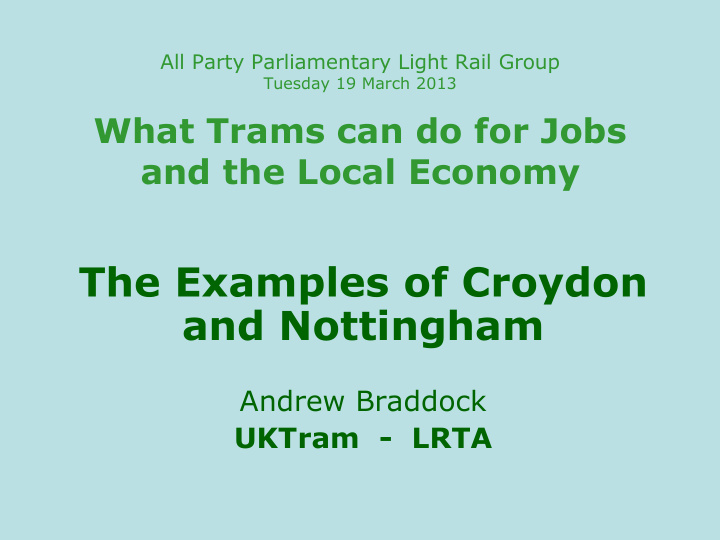



All Party Parliamentary Light Rail Group Tuesday 19 March 2013 What Trams can do for Jobs and the Local Economy The Examples of Croydon and Nottingham Andrew Braddock UKTram - LRTA
Croydon First new tramway in London since closure of the previous London Transport network on 5 July 1952, opened in stages in May 2000 28km network; four lines; 28m passenger journeys per annum Significantly easier access to Croydon town centre £2 billion of inward investment between 1996 and 2002 35% reduction in local unemployment 19% overall increase in retail activity leading to completion of “Centrale” shopping centre with its own tramstop A further £3.5 billion to be invested in Croydon 2020 proposals Proposed extensions to Crystal Palace, Sutton Town Centre, Purley/Coulsdon and Streatham/Brixton
Nottingham New tramway opened in March 2004 14.5km network; two lines; 10m passenger journeys per annum Phase Two extensions to Clifton (7.5km) and Beeston (10km) now under construction Part-funded by Workplace Parking Levy, raising £10 million per annum Employment growth – up to 8,000 jobs boosting the local economy by £390 million per annum Provides enhanced access to 1,270 city centre and 600 Beeston/Chilwell workplaces – 55,000 commuters 20 of the 30 largest employers within 800m of a tramstop Significant improvement in heavy to light rail interchange and potential to serve proposed East Midlands HS2 station Park & Ride spaces increased from 3,000 to over 5,000 Ridership will double to 20 million per annum
Key points Trams are good for jobs and the economy! Cities have 80% of world economic output and 60% of population Urban public transport provides 13 million jobs Investment in public transport creates between 50% and 100% as many jobs as investment in roads (UITP) Every Euro invested in public transport generates EUR 5.00 to 5.30 of added economic value (German study) In Switzerland, each job created in the public transport sector creates 3.3 additional jobs in the regional economy New tramways create unique opportunities to make cities more sustainable and much pleasanter places to live Enhanced mobility for all and reduced social exclusion lead to hidden financial benefits Above all, fixed track public transport gives developers and other investors confidence
Recommend
More recommend